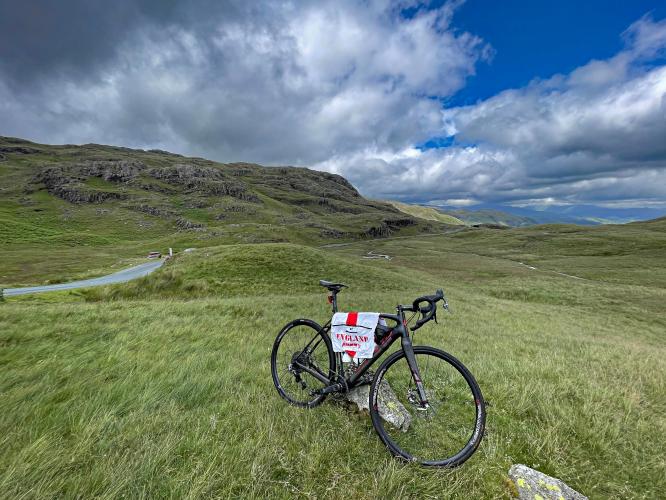![Cycling Wrynose Pass East, England photo shows view down one-lane mountain roadway on foggy, wet day]()
Cycling Wrynose Pass East
Ride 1.6 miles gaining 939’ at 11.4% average grade.
Wrynose Pass from the east is the gateway to some of the most scenic miles in all of Britain. The opening yards pass a few farms, but you’ll soon be on the steep slopes of the mountain - with no points of respite until the summit point. Nearing the summit, rocky mountain tops and boulders surround you as a sweeping left hand turn offers views of the farming land far below. Crest the top, and ahead is a remarkable crescent into a magnificent and relatively untouched valley. While a tough climb on its own, Wrynose Pass takes you into the heart of the Lake District and it would be a crime not to continue the ride west from the summit point and into the valley.
![Cycling Wrynose Pass East, England photo collage; views along mountainside on wet, foggy day, road sign warns of 25% grades, small waterfall along mountainside]()
This is a very remote and difficult climb in the middle of Lake District National Park. The first 250 meters of the climb average 12%, and the first two kilometers are an extremely challenging 13.2% average grade (the final 700 meters of that first segment are at a brutal 17.5%). Hang in there because you can almost coast the final 500 meters to the summit (3.6% average).
![Cycling Wrynose Pass East, England bike parked in front of cattle guard, green pastureland]()
Start of the climb in the Little Langdale Valley.
This is the final climb of the annual Fred Whitton Saddle Back Challenge, one of the most popular sportives in the UK and is one of the toughest of England’s climbs with a quarter-mile averaging 18%. See the PJAMM Fred Whitton Challenge Climb Page for more information on this cycle climbing event. Wrynose Pass is ranked six in England and 14 in the United Kingdom using the Fiets Index, and ranked by Simon Warren as #5 on the England Top 10 list he provided for us before our 2022, two-month tour of the UK to document the top and most epic bike climbs here.
![Cycling Wrynose Pass East, England photo collage shows views of quintessential English countryside, including creek surrounded by pastureland and old stone farm buildings]()
The National Trust owns many farms and areas of land in this area.
![Cycling Wrynose Pass East, England photo collage shows bike parked next to stone retaining wall, small streams behind]()
Many streams in view as we ascend.
![Cycling Wrynose Pass East, England photo collage shows bike parked in grassy hillside along roadside]()
“If Hardknott is the king of climbs, then Wrynose is its queen; slightly softer at the edges but no less ruthless,” Simon Warren (100 Greatest Cycling Climbs, A Road Cyclist’s Guide to Britain’s Hills, p. 145).
![Cycling Wrynose Pass East, England photo collage shows hillsides in fall colors during September, road sign for 25% grade]()
Fall colors during our September 2022 climb.
These climbs are within Lake District National Park, 236,200 hectares (583,663 acres) established in 1951:
“The Lake District, also known as the Lakes or Lakeland, is a mountainous region in North West England. A popular holiday destination, it is famous for its lakes, forests and mountains (or fells) and its associations with the early 19th century writings of William Wordsworth and the other Lake Poets, Beatrix Potter, and John Ruskin. A National Park was established in 1951 and, following a minor extension in 2016, now covers an area of approximately 2,362 square kilometres. It was designated as a UNESCO World Heritage Site in 2017.
It is located entirely within the county of Cumbria, and all the land in England higher than 3,000 feet (914 m) above sea level lies within the National Park, including Scafell Pike, the highest mountain in England. It also contains the deepest and longest bodies of water in England, respectively Wast Water and Windermere” (Wikipedia - Lake District National Park).
![Cycling Wrynose Pass East, England photo collage shows hillsides and landscape in green during July, sheep grazing in heather]()
Summer colors during our July 2018 trip.
![Cycling Wrynose Pass East, England aerial drone view show green hillsides and one-lane country road]()
Upper photos show the final approach to the pass.
![Cycling Wrynose Pass East, England bike parked next to old wooden sign at climb's summit]()
Summit.
![Cycling Wrynose Pass East, England aerial drone view shows views looking back over entire climb, including start near Der Little Langdale Tarn]()
Aerial view from the finish back to the start near Der Little Langdale Tarn.
![]()
That’s a wrap!

 We've partnered with Sherpa-Map.com to bring you the best route planning tool. With a PRO Membership you can use this climb as a reference when creating your route.
We've partnered with Sherpa-Map.com to bring you the best route planning tool. With a PRO Membership you can use this climb as a reference when creating your route. 

